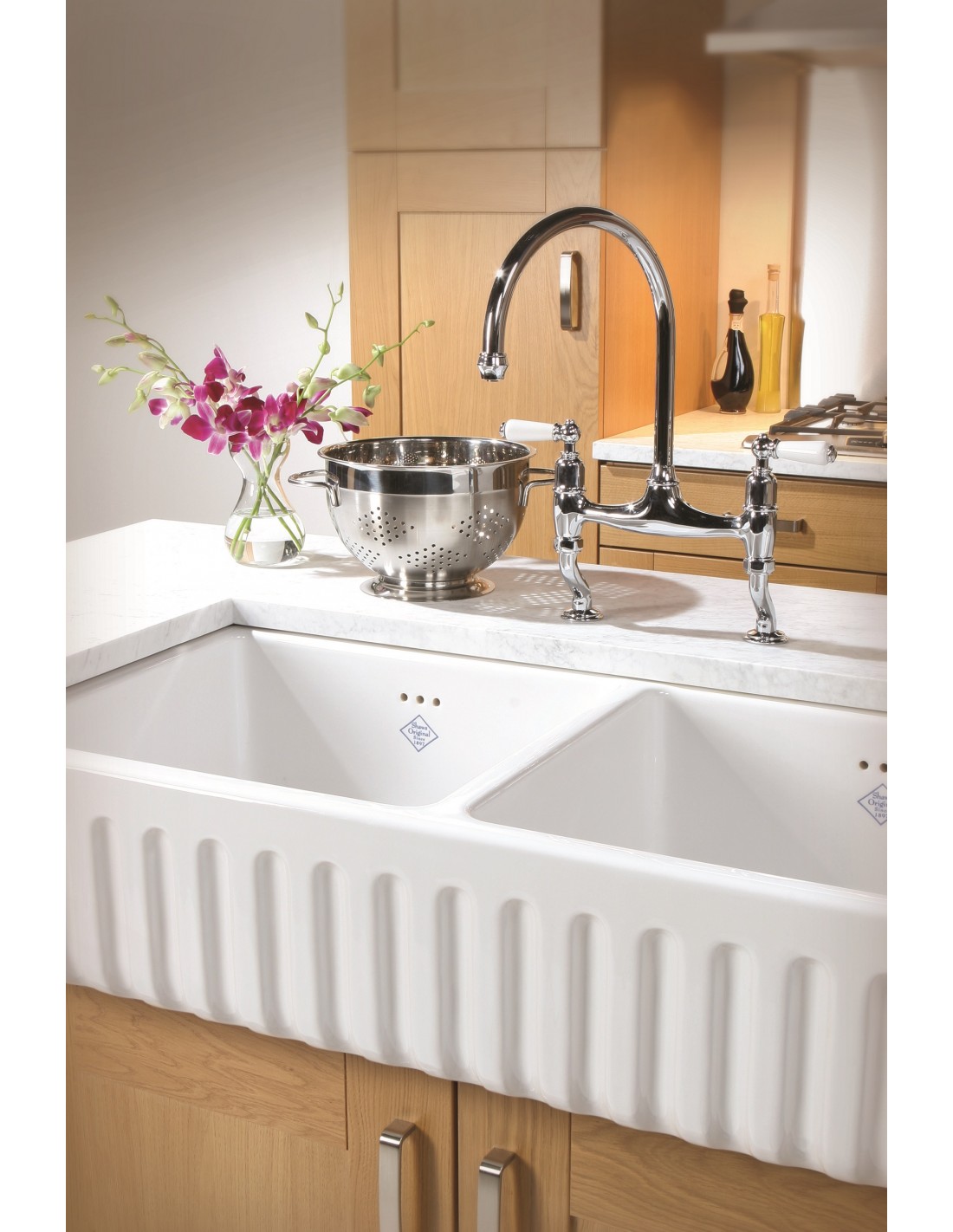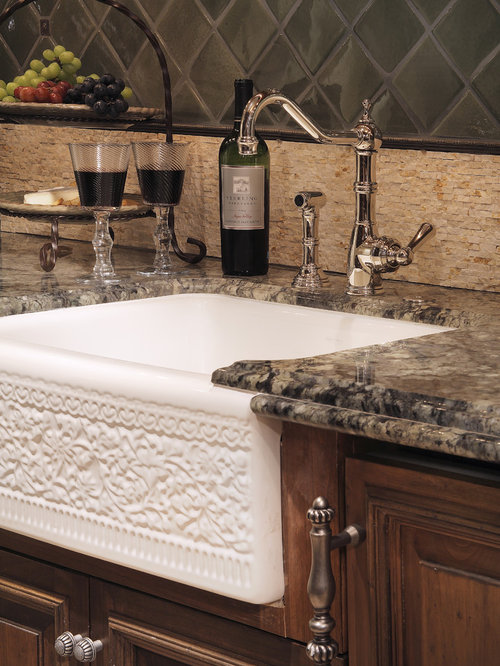Apron kitchen sinks, also known as farmhouse sinks, have been a timeless fixture in homes due to their practical design and aesthetic appeal. These sinks are characterized by their exposed front panel, which extends slightly beyond the counter edge, making them both functional and visually distinctive. Their history dates back to the days when they were primarily used in rural kitchens for heavy-duty tasks like washing large pots, pans, and even clothes. Today, apron sinks are a popular choice for homeowners looking to combine rustic charm with modern convenience in their kitchen designs.
One of the primary reasons people choose an apron kitchen sink is its ergonomic design. Unlike traditional sinks, the apron sink’s protruding front reduces the need to lean forward while washing dishes, which can help alleviate strain on your back. This feature is especially beneficial for people who spend long periods in the kitchen. Additionally, the deeper basin of an apron sink allows for easier handling of oversized cookware, making it a practical choice for avid cooks and large families.

The material of an apron sink plays a crucial role in its performance and appearance. Options include fireclay, stainless steel, cast iron, copper, and even stone. Fireclay sinks are popular for their durability and resistance to staining and scratching, while stainless steel sinks are lightweight, easy to clean, and offer a sleek, contemporary look. Cast iron sinks are coated with enamel, giving them a glossy finish, while copper sinks develop a unique patina over time, adding character to the kitchen. Stone sinks, such as granite or soapstone, are ideal for homeowners seeking a luxurious, natural look.
Installing an apron sink can be a transformative project, but it requires careful planning. Because the sink’s front panel is exposed, the cabinetry beneath must often be customized or modified to fit. This means that retrofitting an apron sink into an existing kitchen may involve additional labor and cost compared to installing a standard drop-in or undermount sink. However, for new kitchen builds or major remodels, an apron sink can seamlessly integrate with your design and become a stunning focal point.

The versatility of apron sinks extends to their styles and configurations. You can choose from single-basin or double-basin designs depending on your needs. Single-basin sinks are spacious and ideal for washing large items, while double-basin sinks provide more flexibility by allowing you to separate tasks like washing and rinsing. Additionally, some apron sinks come with accessories like cutting boards, drying racks, and colanders that make meal preparation and cleanup more efficient.
One of the appeals of apron sinks is their ability to complement a variety of kitchen styles. Whether your kitchen is modern, traditional, farmhouse, or industrial, an apron sink can blend in seamlessly. For example, a fireclay sink with a crisp white finish pairs beautifully with shaker cabinets in a traditional kitchen, while a stainless steel apron sink fits perfectly in a sleek, modern setting. Copper and stone options can enhance rustic or industrial kitchens, adding texture and warmth.

While apron sinks offer numerous advantages, they also have a few drawbacks worth considering. One potential downside is the need for frequent cleaning and maintenance, especially for materials like copper and stone, which are prone to patina and staining. Additionally, the exposed front panel of the sink can be susceptible to scratches and dings, so it’s important to choose a material that aligns with your household’s usage habits. Water splashing can also be more pronounced due to the protruding front, requiring careful installation and a well-chosen faucet to minimize mess.
Caring for an apron sink is relatively straightforward but varies depending on the material. Stainless steel sinks can be wiped down with mild soap and water, while fireclay sinks may need a soft cloth to avoid scratching the surface. Copper sinks require regular polishing to maintain their shine, although some homeowners prefer the natural patina that develops over time. For stone sinks, sealing the surface periodically can help protect against staining and prolong their lifespan.
Apron sinks are a great investment, but they’re not a one-size-fits-all solution. Their larger size means they may not fit comfortably in smaller kitchens, and their weight requires sturdy countertops and cabinets for support. When considering an apron sink, it’s important to measure your kitchen space carefully and consult with a professional if needed. The upfront cost can be higher than that of standard sinks, but the long-term benefits often outweigh the initial expense.

If you’re considering an apron sink, take the time to evaluate your daily kitchen habits and aesthetic preferences. Are you someone who loves cooking and needs ample space for washing large pots and pans? Do you value a sink that doubles as a statement piece? Your answers to these questions can guide you in choosing the right apron sink for your home.
When selecting a faucet for your apron sink, compatibility is key. Since apron sinks often sit lower than standard sinks, the faucet height and reach need to be adequate for the sink’s depth. Pull-down or pull-out faucets work well with apron sinks, providing flexibility for rinsing and cleaning. It’s also important to consider the sink’s material and finish when choosing a faucet to ensure a cohesive look.
For those seeking an environmentally friendly option, consider recycled materials or low-flow faucet attachments for your apron sink setup. Stainless steel sinks made from recycled metal are a sustainable choice, as are certain composite materials. Choosing a sink with a larger basin can also reduce water usage by allowing you to soak and clean multiple items at once rather than running water continuously.

The market for apron sinks has expanded significantly in recent years, offering a wide range of price points and features. Entry-level options made from stainless steel or composite materials can be affordable, while high-end models crafted from copper or natural stone may require a larger investment. It’s worth exploring different brands and models to find a sink that fits both your budget and your lifestyle needs.
Installing an apron sink can be a DIY project for experienced individuals, but for most homeowners, hiring a professional ensures the best results. Professional installation not only guarantees proper fit and function but also helps prevent potential issues like leaks or uneven alignment. Additionally, professionals can provide valuable advice on maintenance and care to keep your sink looking its best for years to come.
Apron sinks aren’t just practical; they’re also a design statement. The unique, exposed front panel adds character to any kitchen, making it a centerpiece that draws attention. Pairing your sink with complementary countertops and backsplash materials can elevate the overall look of your kitchen and tie the design together. Whether you prefer a rustic farmhouse style or a sleek modern aesthetic, an apron sink can enhance your kitchen’s appeal.

Common Mistakes to Avoid
Incorrect Measurements: One of the most common mistakes when installing an apron sink is failing to measure accurately. Because these sinks are larger and have a different configuration than standard sinks, even a slight miscalculation can lead to installation issues. Always measure the sink’s width, depth, and height carefully and ensure your cabinetry can accommodate the size.
Ignoring Cabinet Reinforcement: Apron sinks are often heavier than standard sinks, especially when made from materials like cast iron or stone. Skipping the step of reinforcing the cabinet base can result in structural damage over time. Always ensure your cabinets are strong enough to support the weight of the sink and water-filled basin.
Choosing the Wrong Material: Not all materials suit every household. For example, copper sinks require regular maintenance, which may not be ideal for busy families. Similarly, stainless steel sinks may scratch easily, so they may not be the best choice for homes with heavy use. Understand the pros and cons of each material before making a decision.
Poor Faucet Selection: Pairing your apron sink with an incompatible faucet can result in a disjointed appearance or functional challenges. Ensure the faucet height and reach align with the sink’s dimensions and that the finishes complement each other for a cohesive look.
Skipping Regular Maintenance: Apron sinks require specific cleaning routines depending on their material. Neglecting maintenance can lead to stains, scratches, or corrosion. Be diligent about following care instructions to preserve your sink’s appearance and functionality.
Overlooking Splash Zones: The exposed front of an apron sink can lead to more water splashing onto adjacent cabinets and floors. Installing a proper backsplash and ensuring a good seal between the sink and countertop can help mitigate this issue.
What is the difference between an apron sink and a farmhouse sink?
These terms are often used interchangeably, but they generally refer to the same style of sink with an exposed front panel. The term “farmhouse sink” emphasizes its traditional, rustic origins, while “apron sink” highlights its distinctive design.
Are apron sinks difficult to install?
Installing an apron sink can be more complex than a standard sink because it often requires custom cabinetry or modifications. While it’s possible to install one yourself if you have the necessary skills, hiring a professional is usually recommended for the best results.
Do apron sinks come in standard sizes?
Apron sinks are available in a variety of sizes, but they are generally larger than standard sinks. Common widths range from 24 to 36 inches, and the depth can vary. Always measure your space carefully and consult with a supplier to ensure a good fit.

What is the most durable material for an apron sink?
Fireclay and stainless steel are among the most durable materials. Fireclay is resistant to scratches and stains, while stainless steel is lightweight, corrosion-resistant, and easy to clean. The best material for you depends on your usage habits and aesthetic preferences.
How do I prevent scratches on my apron sink?
Using a sink grid or mat can protect the bottom of your sink from scratches caused by heavy cookware. Additionally, clean the sink with non-abrasive products and avoid using harsh chemicals that could damage the surface.
Are apron sinks worth the investment?
Yes, apron sinks offer a combination of practicality, durability, and aesthetic appeal. While they may have a higher upfront cost, their functionality and timeless design make them a valuable addition to any kitchen.

Related Posts:
